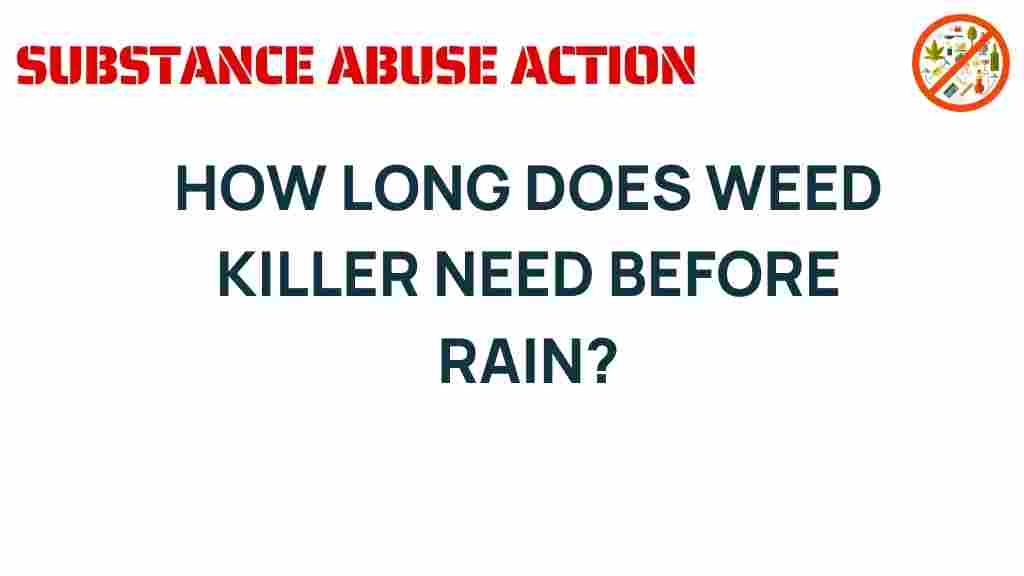The Timing Dilemma: How Long Must Weed Killer Set Before Rain?
When it comes to gardening and maintaining a beautiful lawn, understanding how to effectively use weed killer is crucial. One of the most common dilemmas gardeners face is the timing of weed killer application and the potential impact of rain. This article will explore how long weed killer must set before rain, ensuring you achieve an effective treatment for your garden. We will cover the importance of application timing, factors that influence this timing, and tips for ensuring the best results.
Understanding Weed Killer and Its Importance
Weed killers, or herbicides, are essential tools for gardeners looking to maintain healthy plants and a vibrant landscape. They work by targeting unwanted plants, allowing your desired flora to thrive without competition. However, the effectiveness of weed killer is highly dependent on proper application timing and environmental conditions, especially the presence of rain.
Why Timing Matters
Applying weed killer correctly is vital for several reasons:
- Maximizing Effectiveness: Proper timing ensures that the weed killer can be absorbed by the target plants before being washed away.
- Minimizing Environmental Impact: Timing your application to avoid rain reduces the risk of herbicides entering waterways and harming beneficial plants.
- Cost Efficiency: Applying weed killer at the right time helps you avoid wasting product due to ineffective treatments.
The Science Behind Rain and Weed Killer
Understanding how weed killers interact with rain is key to successful gardening. Once applied, most weed killers require a certain amount of time to adhere to the plant’s leaves and be absorbed into its system. Rain can wash away the herbicide or dilute its concentration, significantly reducing its effectiveness.
Factors Affecting Weed Killer Absorption
Several factors influence how long weed killer must set before rain:
- Type of Weed Killer: Different formulations (liquid, granular, systemic) have varying absorption rates and rain resistance.
- Weather Conditions: Temperature and humidity can affect the evaporation rate and drying time of the herbicide.
- Plant Type: Some plants absorb herbicides more quickly than others, influencing how long you should wait before rain.
General Guidelines for Application Timing
Here are some general recommendations to ensure effective treatment with weed killer:
Follow Manufacturer Instructions
Always read the label on your weed killer product. Most manufacturers provide specific instructions regarding application timing and how long to wait before rain. However, here are some general guidelines:
- Post-Application Wait Time: Aim to wait at least 24 to 48 hours after applying weed killer before expecting rain.
- Check for Rain Forecasts: Always check weather forecasts for the days following your application. Even a light drizzle can affect the efficacy of the treatment.
Optimal Conditions for Application
For the best results, consider the following conditions when applying weed killer:
- Dry Weather: Choose a day when no rain is forecasted for at least 24 hours.
- Temperature: Apply when temperatures are between 60°F and 85°F for optimal absorption.
- Low Wind: Calm conditions help prevent drift and ensure the herbicide reaches the target plants.
Step-by-Step Process for Effective Weed Killer Application
To ensure your weed killer is most effective, follow these steps:
Step 1: Choose the Right Weed Killer
Select a weed killer that is best suited for your specific needs—whether targeting broadleaf weeds, grassy weeds, or tough perennial plants. Research the active ingredients to understand how they work.
Step 2: Prepare the Area
Clear the area of debris, and mow the lawn prior to application. This ensures the herbicide can reach the leaves of the weeds effectively.
Step 3: Apply the Weed Killer
Use a sprayer or spreader according to the instructions provided. Ensure even coverage on the target weeds for maximum efficacy.
Step 4: Monitor Weather Conditions
After application, keep an eye on the weather. If rain is forecasted within the next 24 to 48 hours, consider rescheduling your application.
Step 5: Evaluate Results
After a few days, check the area for signs of weed die-off. If you notice that the weeds are not wilting, you may need to reapply the product after a suitable interval.
Troubleshooting Tips for Weed Killer Application
Despite careful planning, you may encounter issues when applying weed killer. Here are some troubleshooting tips:
Issue 1: Rain Falls Soon After Application
If rain occurs shortly after application, assess the amount of rainfall. A light drizzle may not wash away the herbicide, while heavy rain could necessitate reapplication.
Issue 2: Weeds Are Not Dying
If the weeds do not appear to be affected after the expected timeframe, consider the following:
- Reapply: Wait the recommended time and reapply the herbicide.
- Check Concentration: Ensure the product was mixed correctly if diluted.
- Identify Weeds: Confirm that the weed type is susceptible to the chosen herbicide.
Issue 3: Environmental Concerns
If you’re worried about the impact of weed killer on beneficial plants or wildlife, consider using organic or less toxic alternatives. Always follow application guidelines to minimize harm.
Conclusion
In conclusion, understanding the timing dilemma of applying weed killer before rain is essential for successful gardening. By following the steps outlined in this article, you can ensure effective treatment and maintain a beautiful garden. Remember to always check the weather forecast, read product labels, and adjust your application techniques based on environmental conditions. With careful planning, you can effectively manage weeds without jeopardizing the health of your garden.
For more tips on gardening and effective weed management, check out this comprehensive gardening guide. And for the latest on eco-friendly gardening practices, visit this external resource.
This article is in the category Treatment and created by SubstanceAbuseAction Team
